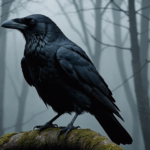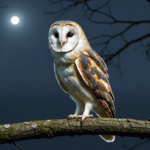The Black Swift: Not to be Confused with the Swallow
The Black Swift (Apus apus) is a member of the apodidae family and is often mistaken for the window or barn swallow. However, it can easily be distinguished by its shorter tail and arc-shaped wings, which are reminiscent of a boomerang. This bird is capable of impressive aerial acrobatics and can be seen performing remarkable feats in the sky during the early summer. Interestingly, the Black Swift can remain in flight for up to ten months without landing, even to sleep! This is because it is not comfortable on land due to its short legs.
In addition to the Black Swift, there are two other species of swifts that regularly nest in Europe: the pale swift (Apus pallidus) and the little swift (Tachymarptis melba).
Characteristics of the Black Swift
- Order: Apodiformes
- Family: Apodidae
- Genus: Apus
- Species: apus
The Black Swift can be easily recognized by its long, slender wings, which it consistently holds back when flying. It measures only 17 cm in length but has a wingspan of 42 cm to 48 cm and weighs between 38 g and 45 g on average. Its plumage is dark brown, almost black, with a slightly lighter throat. Its distinctive large head and hunched neck are also easily recognizable.
The Black Swift has an elongated body and a forked tail, which allows it to be one of the fastest flying birds. In fact, it can reach speeds of up to 200 kilometers per hour. It alternates between rapid wing beats and long glides, taking advantage of its aerodynamic shape. This bird spends most of its time in the air because its legs are too short to land normally on the ground or on a perch like most other birds. As a result, it feeds, drinks, and even sleeps while flying. During the summer, it can be seen flying rapidly in groups at low altitudes before soaring high into the sky at night.
The Black Swift emits high-pitched screeching sounds, especially when flying in groups before dusk. This unique sound is more reminiscent of a high-pitched whistle rather than a characteristic song the bird sings.
Distinguishing the Black Swift from the Swallow
The Black Swift and the swallow have similar silhouettes when in flight, making it challenging to distinguish between the two. However, there are a few key features to look out for:
- Silhouette: The Black Swift is larger than the swallow and has a less pronounced V-shaped tail, similar to the window swallow. In contrast, the barn swallow has a deeply forked tail.
- Color: The Black Swift is almost entirely black, except for a small lighter patch on its throat. In comparison, the window swallow has bluish-black upperparts and white underparts, while the barn swallow has metallic black upperparts and whitish underparts with a red throat.
- Flight: The Black Swift is faster than swallows and has a boomerang-shaped flight pattern. It is often heard more than seen.
A Great Migrator
The Black Swift is a skilled flyer and a great migrator. It leaves our territories en masse at the end of summer, sometimes as early as the end of July, and returns between mid-April and mid-May.
This constant traveler never stops flying, whether it’s for rapid pursuits or reconnaissance flights where it briefly lands and takes off again. Despite its comfort in the air, it dislikes being on firm ground. Once on the ground, it is difficult for the Black Swift to take flight again due to its large wings and small legs. While it can be challenging for the bird to take off from bare ground, it becomes impossible when there is vegetation. However, it can be assisted by gently picking it up and throwing it into the air to help it take off.
The Black Swift also possesses the incredible ability to sleep while in flight. It ascends in flocks at dusk, reaching such high altitudes that it is no longer visible or audible. Studies have shown that the bird can glide at high altitudes of up to 2,000 meters all night before descending in the morning.
Habitat of the Black Swift
This Eurasian species is found from the Atlantic coast to northeastern China and from the Arctic Circle to North Africa and the Middle East. It winters in Africa, south of the equator.
In Europe, the Black Swift can be found in cities, countryside villages, plains, mountains, and above bodies of water. Although it primarily nests in rocky habitats, it has shifted its nesting preference to man-made structures such as old buildings, industrial sites, silos, bridges, and chimneys.
An Insectivorous Diet
The Black Swift feeds on insects that it catches while in flight. Aphids, beetles, and flying ants make up the majority of its diet. It hunts at various altitudes, from low to high in the sky, depending on the availability of prey.
Although it has a small beak, its mouth is wide open to allow as many insects as possible to enter. Since it consumes small prey, it needs to hunt frequently to satisfy its own needs and those of its young. It stores the prey in its crop, forming small balls. It drinks by using its prey or possibly rainwater, and when it’s very hot, it dips its open beak into the surface of the water.
Reproduction of the Black Swift
The Black Swift is monogamous, with pairs typically staying together for life. They mate in flight, and their nesting period occurs between mid-May and August. These birds build their nests under gutters, on rooftops, in chimneys, or in wall cavities. They choose narrow spaces that they can easily access while flying, using small openings of 3 cm to 4 cm in diameter. Once inside, they crawl to their nests using their short legs.
The nest itself is made of grass, straw, feathers, spiderwebs, and other lightweight materials that the Black Swift collects while flying. It mixes these materials with saliva to form a cup-shaped nest. The female lays 1 to 4 eggs during each breeding season, and both parents take turns incubating the eggs for approximately 20 days.
The Black Swift chicks stay in the nest for a little over 40 days with their parents. They only leave the nest once they can fly independently and are fully capable of finding food on their own. Once they leave the nest, they must fend for themselves.
Is the Black Swift Beneficial to the Garden?
The Black Swift helps control the presence of insects in gardens, especially in the evening. It is a valuable aid in eradicating these tiny pests that can damage plants and vegetable gardens.
While the Black Swift is not currently threatened, there have been localized population declines. The scarcity of suitable nesting spaces, particularly due to building renovations, is a significant concern.



